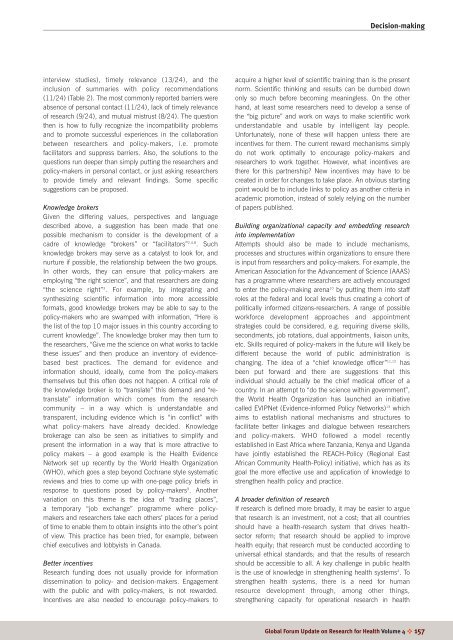Combining health and social protection measures to reach the ultra ...
Combining health and social protection measures to reach the ultra ...
Combining health and social protection measures to reach the ultra ...
- No tags were found...
You also want an ePaper? Increase the reach of your titles
YUMPU automatically turns print PDFs into web optimized ePapers that Google loves.
Decision-makinginterview studies), timely relevance (13/24), <strong>and</strong> <strong>the</strong>inclusion of summaries with policy recommendations(11/24) (Table 2). The most commonly reported barriers wereabsence of personal contact (11/24), lack of timely relevanceof research (9/24), <strong>and</strong> mutual mistrust (8/24). The question<strong>the</strong>n is how <strong>to</strong> fully recognize <strong>the</strong> incompatibility problems<strong>and</strong> <strong>to</strong> promote successful experiences in <strong>the</strong> collaborationbetween researchers <strong>and</strong> policy-makers, i.e. promotefacilita<strong>to</strong>rs <strong>and</strong> suppress barriers. Also, <strong>the</strong> solutions <strong>to</strong> <strong>the</strong>questions run deeper than simply putting <strong>the</strong> researchers <strong>and</strong>policy-makers in personal contact, or just asking researchers<strong>to</strong> provide timely <strong>and</strong> relevant findings. Some specificsuggestions can be proposed.Knowledge brokersGiven <strong>the</strong> differing values, perspectives <strong>and</strong> languagedescribed above, a suggestion has been made that onepossible mechanism <strong>to</strong> consider is <strong>the</strong> development of acadre of knowledge “brokers” or “facilita<strong>to</strong>rs” 2,4,8 . Suchknowledge brokers may serve as a catalyst <strong>to</strong> look for, <strong>and</strong>nurture if possible, <strong>the</strong> relationship between <strong>the</strong> two groups.In o<strong>the</strong>r words, <strong>the</strong>y can ensure that policy-makers areemploying “<strong>the</strong> right science”, <strong>and</strong> that researchers are doing“<strong>the</strong> science right” 3 . For example, by integrating <strong>and</strong>syn<strong>the</strong>sizing scientific information in<strong>to</strong> more accessibleformats, good knowledge brokers may be able <strong>to</strong> say <strong>to</strong> <strong>the</strong>policy-makers who are swamped with information, “Here is<strong>the</strong> list of <strong>the</strong> <strong>to</strong>p 10 major issues in this country according <strong>to</strong>current knowledge”. The knowledge broker may <strong>the</strong>n turn <strong>to</strong><strong>the</strong> researchers, “Give me <strong>the</strong> science on what works <strong>to</strong> tackle<strong>the</strong>se issues” <strong>and</strong> <strong>the</strong>n produce an inven<strong>to</strong>ry of evidencebasedbest practices. The dem<strong>and</strong> for evidence <strong>and</strong>information should, ideally, come from <strong>the</strong> policy-makers<strong>the</strong>mselves but this often does not happen. A critical role of<strong>the</strong> knowledge broker is <strong>to</strong> “translate” this dem<strong>and</strong> <strong>and</strong> “retranslate”information which comes from <strong>the</strong> researchcommunity – in a way which is underst<strong>and</strong>able <strong>and</strong>transparent, including evidence which is “in conflict” withwhat policy-makers have already decided. Knowledgebrokerage can also be seen as initiatives <strong>to</strong> simplify <strong>and</strong>present <strong>the</strong> information in a way that is more attractive <strong>to</strong>policy makers – a good example is <strong>the</strong> Health EvidenceNetwork set up recently by <strong>the</strong> World Health Organization(WHO), which goes a step beyond Cochrane style systematicreviews <strong>and</strong> tries <strong>to</strong> come up with one-page policy briefs inresponse <strong>to</strong> questions posed by policy-makers 9 . Ano<strong>the</strong>rvariation on this <strong>the</strong>me is <strong>the</strong> idea of “trading places”,a temporary “job exchange” programme where policymakers<strong>and</strong> researchers take each o<strong>the</strong>rs’ places for a periodof time <strong>to</strong> enable <strong>the</strong>m <strong>to</strong> obtain insights in<strong>to</strong> <strong>the</strong> o<strong>the</strong>r’s poin<strong>to</strong>f view. This practice has been tried, for example, betweenchief executives <strong>and</strong> lobbyists in Canada.Better incentivesResearch funding does not usually provide for informationdissemination <strong>to</strong> policy- <strong>and</strong> decision-makers. Engagementwith <strong>the</strong> public <strong>and</strong> with policy-makers, is not rewarded.Incentives are also needed <strong>to</strong> encourage policy-makers <strong>to</strong>acquire a higher level of scientific training than is <strong>the</strong> presentnorm. Scientific thinking <strong>and</strong> results can be dumbed downonly so much before becoming meaningless. On <strong>the</strong> o<strong>the</strong>rh<strong>and</strong>, at least some researchers need <strong>to</strong> develop a sense of<strong>the</strong> “big picture” <strong>and</strong> work on ways <strong>to</strong> make scientific workunderst<strong>and</strong>able <strong>and</strong> usable by intelligent lay people.Unfortunately, none of <strong>the</strong>se will happen unless <strong>the</strong>re areincentives for <strong>the</strong>m. The current reward mechanisms simplydo not work optimally <strong>to</strong> encourage policy-makers <strong>and</strong>researchers <strong>to</strong> work <strong>to</strong>ge<strong>the</strong>r. However, what incentives are<strong>the</strong>re for this partnership? New incentives may have <strong>to</strong> becreated in order for changes <strong>to</strong> take place. An obvious startingpoint would be <strong>to</strong> include links <strong>to</strong> policy as ano<strong>the</strong>r criteria inacademic promotion, instead of solely relying on <strong>the</strong> numberof papers published.Building organizational capacity <strong>and</strong> embedding researchin<strong>to</strong> implementationAttempts should also be made <strong>to</strong> include mechanisms,processes <strong>and</strong> structures within organizations <strong>to</strong> ensure <strong>the</strong>reis input from researchers <strong>and</strong> policy-makers. For example, <strong>the</strong>American Association for <strong>the</strong> Advancement of Science (AAAS)has a programme where researchers are actively encouraged<strong>to</strong> enter <strong>the</strong> policy-making arena 10 by putting <strong>the</strong>m in<strong>to</strong> staffroles at <strong>the</strong> federal <strong>and</strong> local levels thus creating a cohort ofpolitically informed citizens-researchers. A range of possibleworkforce development approaches <strong>and</strong> appointmentstrategies could be considered, e.g. requiring diverse skills,secondments, job rotations, dual appointments, liaison units,etc. Skills required of policy-makers in <strong>the</strong> future will likely bedifferent because <strong>the</strong> world of public administration ischanging. The idea of a “chief knowledge officer” 11,12 hasbeen put forward <strong>and</strong> <strong>the</strong>re are suggestions that thisindividual should actually be <strong>the</strong> chief medical officer of acountry. In an attempt <strong>to</strong> “do <strong>the</strong> science within government”,<strong>the</strong> World Health Organization has launched an initiativecalled EVIPNet (Evidence-informed Policy Networks) 13 whichaims <strong>to</strong> establish national mechanisms <strong>and</strong> structures <strong>to</strong>facilitate better linkages <strong>and</strong> dialogue between researchers<strong>and</strong> policy-makers. WHO followed a model recentlyestablished in East Africa where Tanzania, Kenya <strong>and</strong> Ug<strong>and</strong>ahave jointly established <strong>the</strong> REACH-Policy (Regional EastAfrican Community Health-Policy) initiative, which has as itsgoal <strong>the</strong> more effective use <strong>and</strong> application of knowledge <strong>to</strong>streng<strong>the</strong>n <strong>health</strong> policy <strong>and</strong> practice.A broader definition of researchIf research is defined more broadly, it may be easier <strong>to</strong> arguethat research is an investment, not a cost; that all countriesshould have a <strong>health</strong>-research system that drives <strong>health</strong>sec<strong>to</strong>rreform; that research should be applied <strong>to</strong> improve<strong>health</strong> equity; that research must be conducted according <strong>to</strong>universal ethical st<strong>and</strong>ards; <strong>and</strong> that <strong>the</strong> results of researchshould be accessible <strong>to</strong> all. A key challenge in public <strong>health</strong>is <strong>the</strong> use of knowledge in streng<strong>the</strong>ning <strong>health</strong> systems 4 . Tostreng<strong>the</strong>n <strong>health</strong> systems, <strong>the</strong>re is a need for humanresource development through, among o<strong>the</strong>r things,streng<strong>the</strong>ning capacity for operational research in <strong>health</strong>Global Forum Update on Research for Health Volume 4 ✜ 157















![[re-tender] RFQ for supply of Diesel Generator - Brac](https://img.yumpu.com/44421374/1/186x260/re-tender-rfq-for-supply-of-diesel-generator-brac.jpg?quality=85)
